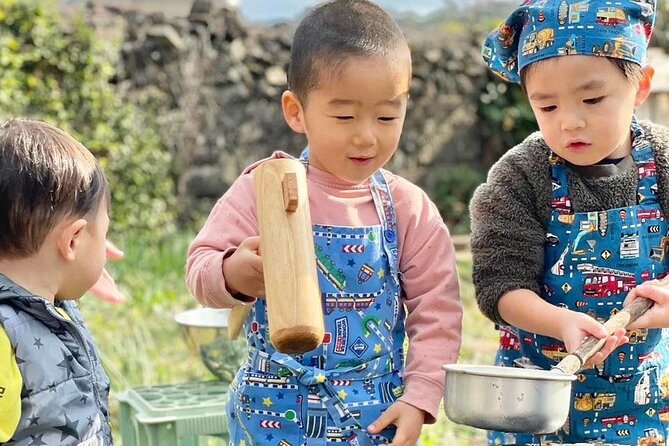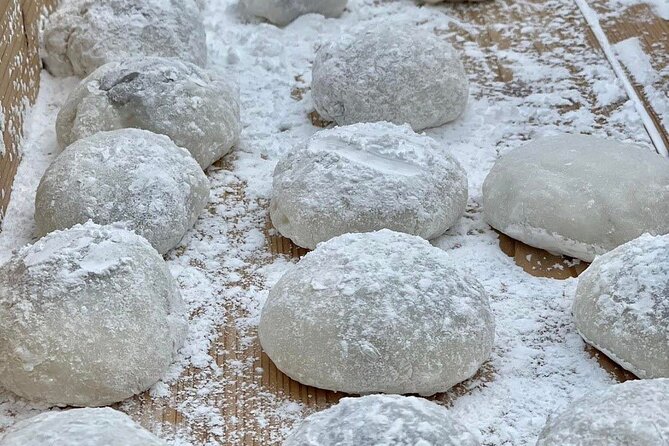Tucked away in the serene waters of the Goto Islands, Ojika Island offers a unique cultural experience for visitors – mochitsuki. This traditional rice cake-making activity invites guests to don aprons and join skilled artisans in pounding steamed rice into a soft, pliable dough. As participants shape and decorate their creations, they’ll discover the rich heritage and significance of this cherished Japanese culinary tradition. What unfolds is a festive, collaborative atmosphere that showcases the island’s vibrant community spirit.
Key Points

- Ojika Island offers a hands-on mochitsuki experience where participants learn traditional techniques of pounding and shaping sticky rice into mochi.
- The mochitsuki process involves rhythmic pounding of steamed rice in a stone mortar using a wooden mallet, followed by shaping and decorating the mochi.
- Participants have the opportunity to create mochi filled with sweet red bean paste, highlighting the rich culinary heritage of Japan.
- The mochitsuki experience on Ojika Island provides insights into the cultural significance of this ritual, which symbolizes renewal and community.
- The festive atmosphere and guidance from local experts ensure a memorable and immersive encounter with the centuries-old tradition of mochi making.
Overview of Mochitsuki Rice Cake Making

Although mochi, the traditional Japanese rice cake, is enjoyed year-round, the mochitsuki, or mochi-making process, holds a special significance during the New Year’s celebrations.
Participants in the Mochitsuki Rice Cake Making Experience on Ojika Island will learn the traditional techniques of pounding steamed sticky rice into a smooth, elastic dough using a wooden mallet and a large mortar.
They’ll then shape the mochi into bite-sized pieces, often filling them with sweet red bean paste.
This hands-on activity offers a glimpse into the rich cultural heritage and culinary traditions of Japan.
You can also read our reviews of more tours and experiences in Nagasaki.
Traditional Mochitsuki Process

The traditional mochitsuki process involves several key steps. First, steamed sticky rice is pounded with a wooden mallet in a stone mortar. This rhythmic pounding softens the rice and builds a sticky, pliable dough. Next, the dough is kneaded and folded to develop its texture. Finally, the mochi is shaped into small balls or other forms, ready to be flavored and enjoyed.
| Step | Action | Purpose |
|---|---|---|
| 1 | Pound steamed rice in mortar | Soften rice, develop dough |
| 2 | Knead and fold dough | Improve texture |
| 3 | Shape mochi | Prepare for flavoring |
The mochitsuki process preserves a centuries-old Japanese tradition, where the rhythmic pounding and meticulous shaping create a uniquely satisfying treat.
Ingredients and Materials

To create the traditional mochi, you will need a set of specialized ingredients and materials. First, they’ll use sweet short-grain rice, which gives mochi its signature sticky texture.
Freshly pounded mochi dough requires a wooden mallet and mortar. Participants also need a wooden mallet, a cutting board, and a knife to shape the mochi.
Tucking the mochi into an anko (sweet red bean paste) filling requires additional ingredients like anko, soy sauce, and sometimes kinako (roasted soybean powder).
With the right tools and ingredients, the group will craft their own authentic mochi delicacies.
Hands-on Mochitsuki Experience
Participants begin their hands-on mochitsuki experience by gathering around a traditional wooden mallet and mortar. Under the guidance of a local expert, they take turns pounding the steamed rice into a smooth, pliable dough. The rhythmic thump of the mallet and the lively chatter create a festive atmosphere. Once the mochi is ready, participants shape it into small balls, decorate them, and enjoy their creations alongside traditional snacks and beverages.
| Step | Description |
|---|---|
| 1 | Pound steamed rice in a wooden mortar with a wooden mallet |
| 2 | Knead the rice dough until smooth and pliable |
| 3 | Shape the mochi into small balls |
| 4 | Decorate the mochi with various toppings |
Techniques and Traditions

Although mochitsuki has deep roots in Japanese culture, the techniques and traditions involved in this rice cake-making experience go beyond mere historical significance.
Participants will knead and pound the sticky mochi dough using traditional wooden mallets, a physically demanding yet rhythmic process honed over generations. They’ll then shape the pliable dough into small balls, meticulously crafting each piece by hand.
Throughout the experience, an expert guide will share insights into the cultural importance of mochi, from its origins as a celebratory food to its enduring place in Japanese cuisine and festivities.
It’s a hands-on glimpse into centuries-old culinary artistry.
Cultural Significance of Mochitsuki

Mochi, the quintessential Japanese rice cake, holds profound cultural significance that extends far beyond its delectable taste and textural allure.
Mochitsuki, the traditional act of pounding steamed rice into a smooth, pliable dough, is deeply rooted in Japan’s cultural heritage. It’s a cherished communal practice that brings families and communities together, fostering a sense of unity and shared traditions.
The making of mochi holds sacred meaning, symbolizing renewal, prosperity, and the cyclical nature of life. This time-honored ritual reflects Japan’s reverence for nature, appreciation for craftsmanship, and dedication to preserving time-honored customs.
Experiencing Ojika Island
Nestled in the serene waters of the Genkai Sea, Ojika Island offers visitors a captivating glimpse into Japan’s rich cultural tapestry.
The Mochitsuki rice cake making experience is but one of the island’s alluring attractions. Participants are immersed in the time-honored tradition, guided by local experts as they knead, pound, and shape the sticky rice into delectable morsels.
Beyond the hands-on activity, the experience includes sampling traditional snacks and sipping refreshing beverages, providing a well-rounded culture.
Ojika’s tranquil natural beauty and enduring cultural practices create a truly memorable encounter for those seeking an authentic Japanese experience.
Enjoying the Final Mochi
With the rice cakes meticulously crafted, it’s time to savor the final mochi.
First, admire the soft, pounded dough – a canvas for your culinary creativity.
Next, select your favorite toppings, like sweet red bean paste or earthy matcha powder.
Finally, relish each heavenly bite, as the pillowy texture melts in your mouth.
The balanced sweetness and chewy delight are the rewards of your hard work.
Delight in this time-honored tradition, where the harmony of flavor and texture transports you to the heart of Japanese culture on Ojika Island.
Since You Asked
What Are the Safety Guidelines for the Mochitsuki Experience?
The experience involves using traditional rice cake making techniques, so participants should follow the guide’s instructions carefully, wear appropriate clothing, and take necessary precautions when handling hot equipment. Safety is the top priority for the tour.
Can Participants Take the Leftover Mochi Home With Them?
Yes, participants can take home any leftover mochi from the experience. The tour includes all the necessary materials and instructions for making the traditional rice cakes, allowing guests to enjoy their handmade creations even after the activity.
Is There a Minimum or Maximum Group Size Requirement?
The experience has a group size of up to 10 participants. There’s no minimum group size, so you can book it even if you’re a solo traveler or a small group.
Are There Any Age Restrictions for Participating in the Activity?
There are no age restrictions for the activity. It’s suitable for travelers of all ages, though children must be accompanied by an adult. The experience is open to individuals, families, and groups.
Can the Experience Be Customized or Personalized for the Group?
The experience can be customized or personalized for the group. Guests can work with the tour operator to adjust the schedule, add special requests, or tailor the activity to their interests and needs.
The Sum Up
The mochitsuki experience on Ojika Island offers visitors a delightful immersion in Japan’s rich culinary heritage. Participants pound sticky rice, craft delicate mochi, and savor the final treats, all while learning about the cultural significance of this time-honored tradition. It’s a memorable opportunity to connect with the island’s vibrant community and traditions, leaving participants with a deeper appreciation for the art of mochitsuki.
More Tour Reviews in Nagasaki
- Huis Ten Bosch Ticket in Nagasaki Japan
- Hasami Ware 2-Day Tour With Special Guide ~ 400 Years History and Modern Daily Use Pottery ~
- Nagasakis Hidden Gems: Private & Personalized Walking Experience
- Sasebo Private Customizable Full Day Tour
- Private Transfer From Sasebo Cruise Port to Fukuoka City Hotels
- Sunset Beach Dinner
Not for you? Here's more nearby things to do in Nagasaki we have reviewed
- Huis Ten Bosch Ticket in Nagasaki Japan
- Hasami Ware 2-Day Tour With Special Guide ~ 400 Years History and Modern Daily Use Pottery ~
- Nagasakis Hidden Gems: Private & Personalized Walking Experience
- Sasebo Private Customizable Full Day Tour
- Private Transfer From Sasebo Cruise Port to Fukuoka City Hotels
- Sunset Beach Dinner
- Make Lunch With Onsen Kitchen in Unzen
- Nagasaki Airport (NGS) to Nagasaki – Round-Trip Private Transfer
- Sea Kayaking and Beach Clean up in Ojika Island Nagasaki
- Nagasaki Heritage Trail: Cathedrals, Bridges & Chinatown
- Mochitsuki Rice Cake Making Experience in Ojika Island
- Nagasaki Airport (NGS) to Nagasaki – Arrival Private Transfer
